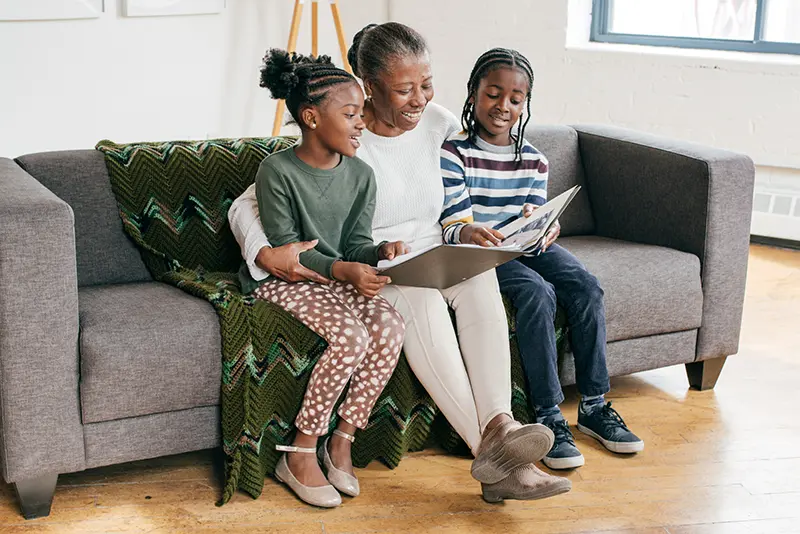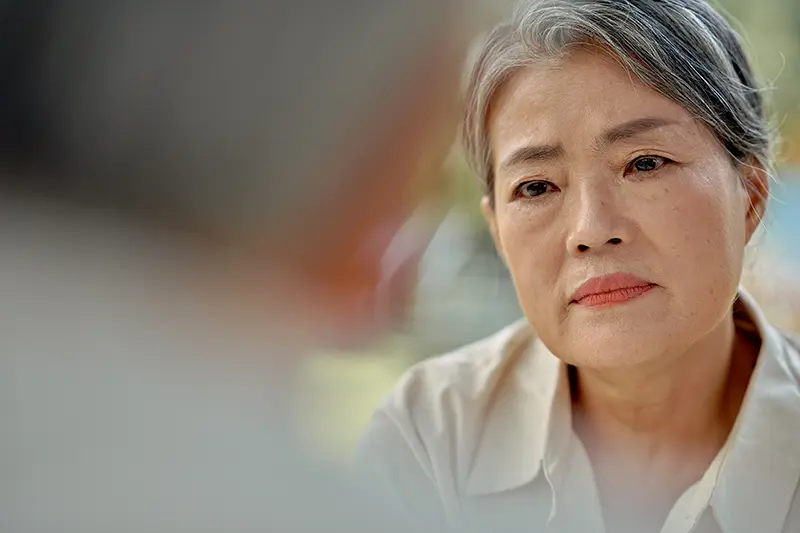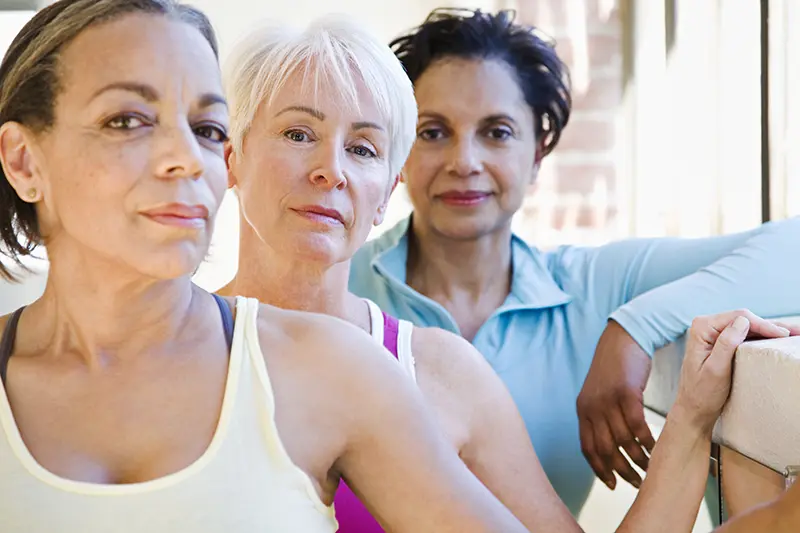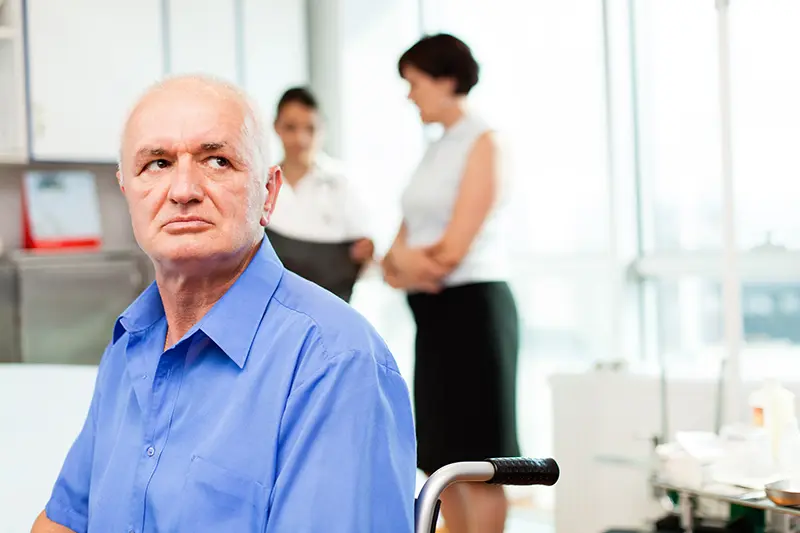Attitudes Towards Aging and Ageism

Age represents a wealth of knowledge because you have lived and learned.
Female, 50-591
- 88% of adults ages 50-80 feel more comfortable being themselves as they have gotten older
- 76% of adults age 50-plus agree they have a lot to look forward to with age
- 82% of adults ages 50-80 experience everyday ageism regularly
- 62% of adults age 45-plus believe ageism is a big problem (20%) or somewhat of a problem (42%) in our society today
- 46% of workers age 50-plus have experienced age discrimination in the workplace since turning 40
Source: Data on comfortable being self, everyday ageism: University of Michigan National Poll on Healthy Aging, “Everyday Ageism and Health,” (July 2020); Data on looking forward: AARP Research, “Healthy Living: A look at how older adults’ resiliency is related to healthy aging,” (May 2022); Data on societal problem: Bonner Cozad, Aisha, Kate Bridges, and Cassandra Cantave. AARP Vital Voices Research, 2022-2024; Data on workplace discrimination: Lona Choi-Allum, “Understanding a Changing Older Workforce: An Examination of Workers Ages 40-Plus,” (January 2023).
When asked how they feel about getting older, adults 50-plus highlight positive perspectives on aging, an understanding that they have valuable contributions to make enhanced by years of accumulated knowledge, wisdom and experience and a lot to look forward to. Older adults also report feeling more comfortable being their authentic selves. At the same time, attitudes towards aging are not just a matter of personal perspective – they are a product of ideas that come from all facets of society and culture. Many recognize ageism when they see it in their everyday lives, and also have internalized negative attitudes towards getting older that could be harmful to their mental and even physical health.2 Topics related to this include:
Ageism Defined
Ageism refers to the stereotypes (how we think), prejudice (how we feel) and discrimination (how we act) directed towards people based on their age, according to the World Health Organization.3 While ageism can affect individuals at any age, we focus on ageism towards older adults here. As stated by the University of Michigan National Poll on Healthy Aging, “Age-based discrimination in employment, housing, and health care can negatively affect older adults’ health and well-being. Older adults may also experience ageism in their day-to-day lives through interpersonal interactions and exposure to ageist beliefs, assumptions, and stereotypes.”4
Attitudes Towards Aging
The vast majority of adults 50-plus report feeling positive about aging and comfortable with themselves as they age. While self-reported positive feelings outshine self-reported negative ones, feelings can be mixed and are influenced by societal and internalized beliefs about age.
Most (81%) older adults 50-plus say they are aging well, and three-quarters (76%) say they have a lot to look forward to as they age. Seven in ten are confident about aging and have optimistic attitudes towards aging.5 Fewer, although still a significant portion agree with statements such as “I worry about being able to live independently,” and “I feel concerned about aging.”
Older adults’ weakest association is with the statement saying “I feel helpless about aging,” indicating that most feel like they are in control of and have agency over their aging process. And of all segments, older Black adults are least likely to say they feel helpless about aging. In general, older Black adults reveal a more positive outlook around aging compared to their White and Hispanic counterparts. They are also most likely to say they will continue to make a difference in the world as they age. This desire for change-making with age embodies Black Americans’ cultural trait of determination.6
Adults 50-plus largely highlight positive associations with aging, although feelings can be mixed.
Strongly or somewhat agree with statement, among adults 50-plus
Older adults feel more comfortable being themselves as they have gotten older.
Strongly agree or agree, among adults ages 50-80

The majority of adults 50-plus see getting older as continued progression, and reject the idea that getting older means decreasing contributions.
Percent agreeing/disagreeing, among adults 50-plus
8 out of 10
adults ages 50-80 report regularly experiencing at least one form of everyday ageism in their day-to-day lives. These forms of ageism include exposure to ageist messages, ageism in interpersonal interactions and internalized ageism (having personally held beliefs about aging and older people).7
While older adults view aging as a process of continued progression, research among older adults also finds internalized ageism.
This includes self-stereotyping, negative self-perceptions of aging, negative attitudes towards one’s own aging, or perceiving oneself as too old.9 In the National Poll on Healthy Aging, thirty-six percent (36%) of adults ages 50–80 endorsed at least one form of internalized ageism based on their agreement that feeling lonely (29%) or feeling depressed, sad, or worried (26%) are a normal part of getting older.10

So many worries go through my mind all the time. Like how many more years do I have and when is my health going to start failing, as I watch my mother-in-law grow older and get weaker every day…My wrinkles and gray hair…
Female, 51, in response to being asked what worries they have12
Almost half of older adults ages 50-80 report experiencing “interpersonal” ageism.
Interpersonal ageism encompasses “experiences involving another person, where the older person felt it was assumed that they were having trouble with using technology, seeing, hearing, understanding, remembering, or doing something independently – or that they don’t do anything valuable.” People who have lower levels of income or education, and those who live in rural areas reported a higher incidence of ageism, along with older adults who reported spending more time watching or reading media.13
Although ageism affects adults of all ages, for many adults, ageism accompanies getting older and is especially felt in one’s 60s in interactions with others.
Two in ten adults in their 50s, compared to over three in ten adults 60 and older reported having experienced ageism in their personal interactions since turning 40 years old to some extent or to a great extent.14 In fact, those in their 60s are most likely to report experiencing ageism compared to their younger and older counterparts.
Those in their 60s are especially likely to report having experienced ageism in personal interactions to at least some extent.
Extent experiencing ageism in personal interactions with others since turning 40 years old, among adults 50-plus
Even more adults than have reported experiencing interpersonal ageism themselves believe that society and culture is organized to discriminate against older people.
Over three in five (62%) adults 50-plus agree that systemic ageism, or discrimination on the basis of age across all levels of society,15 is happening at least to some extent.16 Women and Black adults 50-plus are somewhat more likely to believe this is happening to a great extent, which could be related to intersectionality, that is experiencing sexism, racism, and ageism simultaneously.
Three in five adults 50-plus believe that systemic ageism is happening to at least some extent.
The extent to which adults 50-plus believe society and culture is organized to discriminate against older people

65%
of adults ages 50-80 said they are regularly exposed to ageist messages including seeing, hearing or reading jokes about older people, or messages that older adults are unattractive or undesirable.18
Ageism in Media/Representation
Older adults can not only be misrepresented in media via visual ageism and stereotypes, but they can also not be represented or considered as an audience at all.
One example is advertising that assumes older adults are only interested in a narrow set of products like assistive devices or hearing aids rather than a wide range of products serving their varied interests and well-being overall.19

Women of all ages believe that media and advertising often fail to represent women 50-plus in an authentic way.
Specifically, women 50 and older are represented authentically only about one in three times, according to women of all ages.20
Women do not believe women 50-plus are presented authentically by media and advertising.
Percent of time adult women say women 50-plus are presented authentically in media and advertising, on average
Seven in ten women 50-plus believe it’s important to see themselves in media, but 2 out of 3 report seeing themselves rarely or never.
Among women 50-plus
Women 50-plus see “reducing the signs of aging” to be the most popular beauty standard currently, a sign that ageism is embedded in culture.
According to experts, media’s perpetuation of “anti-aging culture” advances a multi-billion dollar anti-aging consumer industry.21 Only a quarter of women 50-plus indicate beauty standards for women celebrate “being uniquely yourself”, despite older adults embracing the process of getting older.
Reducing signs of aging is perceived to be the most popular beauty standard among women 50-plus.
Percent who believe beauty standards are popular today, by age
Thought Starter
Will preferred terms shift as society and culture evolve?
Ageism at Work

Older workers see and experience age discrimination in the workplace today.
Sixty-five percent (65%) of adults 50-plus in the workforce think workers face age discrimination in the workplace, based on what they have seen or experienced. This number is even higher among groups that have historically experienced workplace discrimination, including African American and Black workers, LGBTQ+ workers and women, related to and explained by the effect of intersectionality and how ageism intersects with other marginalized identities.29 Almost half of workers 50-plus report having experienced age discrimination themselves.
Two-thirds of workers 50-plus report having seen or experienced age discrimination.
Percent of workers 50-plus who say they have seen or experienced age discrimination in the workplace since turning 40
Almost half of workers 50-plus have experienced age discrimination themselves.
Percent of workers 50-plus having experienced age discrimination in the workplace since turning 40
Almost two in five workers 50-plus report having experienced at least one of the following types of discriminatory situations at work because of their age.
Ways in which workers have experienced workplace discrimination in the past three years, among workers 50-plus
Adults 50-plus vary in their emotional responses to discrimination.
Responses to age-based discrimination among workers 50-plus who reported experiencing it
Ageism and Health/Medicine

Health is not only impacted by ageism, but fair or poor health is also correlated with higher perceptions of everyday ageism.
Among adults ages 50-80, higher scores on the Everyday Ageism Scale30 (based on an individual’s answers to 10 questions about their own experiences and beliefs regarding aging), were associated with lower self-reported physical and mental health, number of chronic conditions and depression symptoms.31
Ageism occurs in health care and has a real impact on treatment of older patients.
Ageism in health care can result in misdiagnoses or dismissing conditions as a feature of old age. Older patients with poor hearing may be treated as cognitively impaired or treatable conditions such as chronic pain may be dismissed. Another example of ageism in health care is elderspeak, where providers or staff may address older patients with terms of endearment like “honey” or “dear” which can be patronizing.32,33
According to a World Health Organization report, a 2020 metanalysis showed that in 85% of 149 studies, age determined who received certain medical procedures or treatments. The AMA reports that “older people may be excluded from research studies, which skews results, or shunted off to physicians or other health professionals with limited knowledge of gerontology or less experience in treating of older patients.”34
Ageism may compromise the social life of older adults and lead to loneliness.
Individuals may adopt the stereotypes of old age as a time of loneliness. And age-based discriminatory practices that increase social exclusion of older adults because of mandatory or forced retirement, for example, increase their risk of becoming lonely.36,37
Key Takeaways
-
Most older adults feel positive about the aging process; less than a third of all adults 50-plus indicate feeling helpless about aging, signifying a sense of control and confidence.
-
However, a positive mindset and perceptions of aging as progression do not shield older adults from experiencing ageism, which amplifies in their 60s.
-
Ageism is harmful in all its forms, some explicit, and others, subliminal. These range from everyday ageism in interpersonal interactions, ageist messaging in media and advertising, age discrimination in the workplace, to systemic ageism that becomes internalized.
-
The onus of overcoming internalized ageism must not entirely fall on older adults. Structural factors, institutions, and individual actors all have a role to play in dismantling the ageist ideas that ultimately impact longevity.
See also:
For more information related to attitudes towards aging and ageism, see:
- The Lived Experience of Adults 50-plus: Access to Health Care
- The Lived Experience of Adults 50-plus: Independence and Autonomy
- The Lived Experience of Adults 50-plus: Work
- The Lived Experience of Adults 50-plus: Retirement
- The Lived Experience of Adults 50-plus: Brain and Body Health
- The People Say : Aspirations for Older Age
Sources
- AARP Research, Hispanic Hearts and Minds Study, 2023. (Unpublished.)
- University of Michigan National Poll on Healthy Aging, “Everyday Ageism and Health,” (July 2020).
- World Health Organization. 2023. “Ageism-Global.” https://www.who.int/health-topics/ageism#tab=tab_1.
- University of Michigan National Poll on Healthy Aging, Everyday Ageism and Health.
- AARP Research, “Healthy Living: A look at how older adults’ resiliency is related to healthy aging,” (May 2022), https://www.aarp.org/content/dam/aarp/research/surveys_statistics/health/2022/healthy-living-resiliency-healthy-aging-report.doi.10.26419-2Fres.00533.006.pdf.
- Collage Group, “Cultural Traits Survey” (January 2024). (Not publicly available. Contact Collage Group for details.)
- University of Michigan National Poll on Healthy Aging, Everyday Ageism and Health.
- Mallika Ramachandran, “Review of Ageism Unmasked: Exploring Age Bias and How to End It, By Tracey Gendron,” Jindal Global Law Review, (2022) Vol. 13, no. 2:389–99, doi: 10.1007/s41020-022-00182-9.
- Ayalon L., Tesch-römer C. 2018. Contemporary perspectives on ageism; Bodner E. On the origins of ageism among older and younger adults. International Psychogeriatrics. 2009;21(6):1003–1014.
- University of Michigan National Poll on Healthy Aging, Everyday Ageism and Health.
- Span, Paula. 2022. “Exploring the Health Effects of Ageism.” The New York Times, April 23, 2022, sec. Health.
- Feedback Loop Research, AARP, June 2023. (Unpublished.)
- Emily Henderson, “Study shows close linkages between ageism and health,” (June 2022), https://www.news-medical.net/news/20220615/Study-shows-close-linkages-between-ageism-and-health.aspx; Allen, J.O., et al. (2022) Experiences of Everyday Ageism and the Health of Older US Adults. JAMA Network Open. doi.org/10.1001/jamanetworkopen.2022.17240.
- NORC/AARP Foresight Omnibus (2023). (Unpublished.)
- Episode 10:2 Dr. Tracey Gendron Talks about Systemic Ageism and How to End It.” 2022. Listen Notes. June 5, 2022. https://www.listennotes.com/bg/podcasts/glowing-older/episode-102-dr-tracey-0CuE7HdG5Ys/#google_vignette.
- NORC/AARP Foresight Omnibus (2023). (Unpublished.)
- Mallika Ramachandran, Review of Ageism Unmasked: Exploring Age Bias and How to End It, By Tracey Gendron.
- University of Michigan National Poll on Healthy Aging, Everyday Ageism and Health.
- Mallika Ramachandran, Review of Ageism Unmasked: Exploring Age Bias and How to End It, By Tracey Gendron.
- AARP Research, “Mirror/Mirror: AARP Survey of Women’s Reflections on Beauty, Age and Media,” (September 2023), https://www.aarp.org/pri/topics/aging-experience/demographics/women-reflections-beauty-age-media-2023.html.
- Mallika Ramachandran, Review of Ageism Unmasked: Exploring Age Bias and How to End It, By Tracey Gendron.
- “The New Age of Aging: An Age Wave Study,” (2023), https://agewave.com/wp-content/uploads/2023/08/08-07-23-Age-Wave-The-New-Age-of-Aging-Report_FINAL.pdf.
- Mallika Ramachandran, Review of Ageism Unmasked: Exploring Age Bias and How to End It, By Tracey Gendron.
- Tracy Frey and Roxanne K. Young, “Correct and Preferred Usage,” AMA Manual of Style: A Guide for Authors and Editors, (Feb. 2020).
- APA, “Age”.
- James Appleby, “Revised Style Guides Advance Age-Inclusive Language.”
- AP Updates.
- “What Is Old Age?” 2015. World Economic Forum.
- Lona Choi-Allum, “Understanding a Changing Older Workforce: An Examination of Workers Ages 40-Plus,” (January 2023).
- Allen JO, Solway E, Kirch M, Singer D, Kullgren JT, Moïse V, Malani PN. Experiences of Everyday Ageism and the Health of Older US Adults. JAMA Netw Open. 2022 Jun 1;5(6):e2217240. doi: 10.1001/jamanetworkopen.2022.17240. PMID: 35704314; PMCID: PMC9201677.
- Emily Henderson, “Study shows close linkages between ageism and health,” (June 2022).
- UCLA Health, “Ageism is prevalent in medical care.”
- Allen, J.O., et al. (2022) Experiences of Everyday Ageism and the Health of Older US Adults. JAMA Network Open. doi.org/10.1001/jamanetworkopen.2022.17240.
- AMA, “https://www.ama-assn.org/delivering-care/population-care/ageism-creeping-your-care-older-adults.” (2022).
- Mallika Ramachandran, Review of Ageism Unmasked: Exploring Age Bias and How to End It, By Tracey Gendron.
- Mallika Ramachandran, Review of Ageism Unmasked: Exploring Age Bias and How to End It, By Tracey Gendron.
- Shiovitz-Ezra S, Erlich B, Ayalon L. Short- and Medium-Term Effects of Ageism on Loneliness Experienced During the COVID-19 Pandemic. J Appl Gerontol. 2023 Jun;42(6):1255-1266. doi: 10.1177/07334648231159372. Epub 2023 Feb 21. PMID: 36809924; PMCID: PMC9947391.